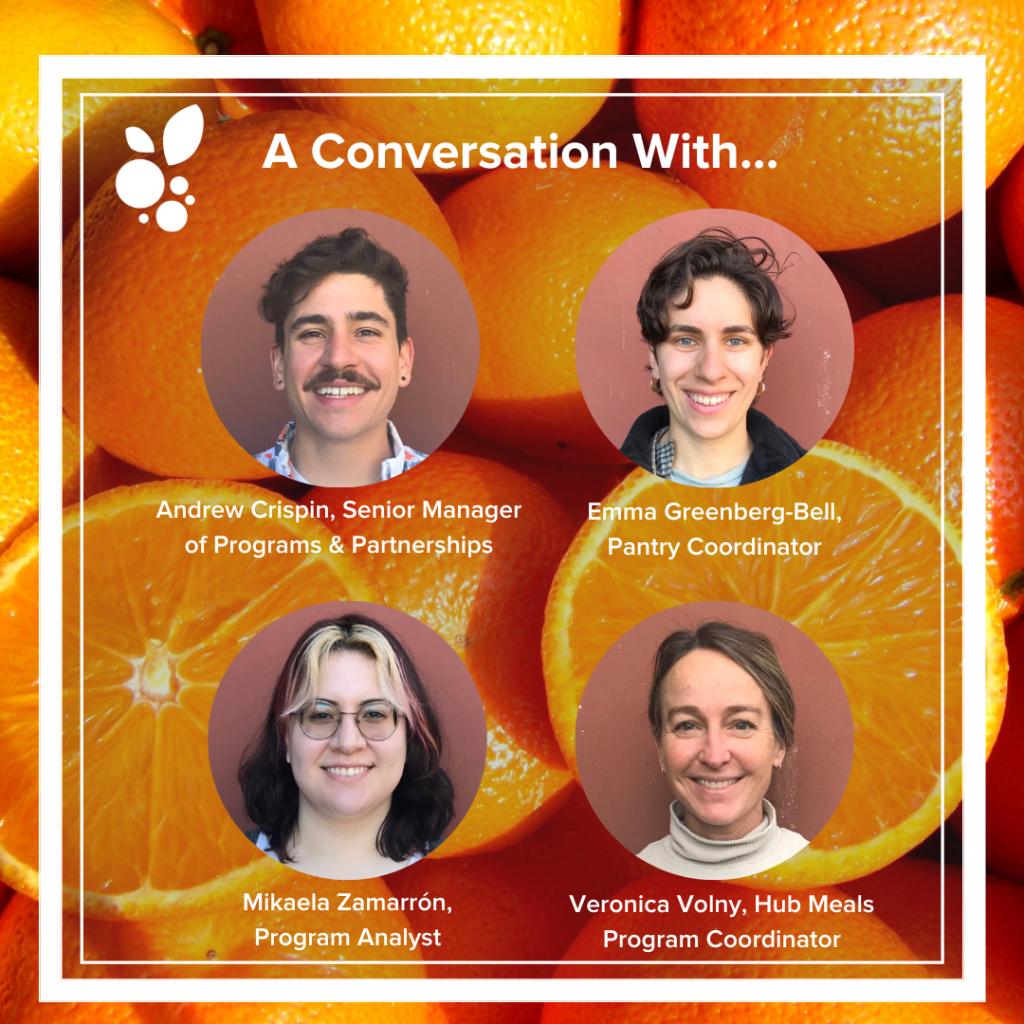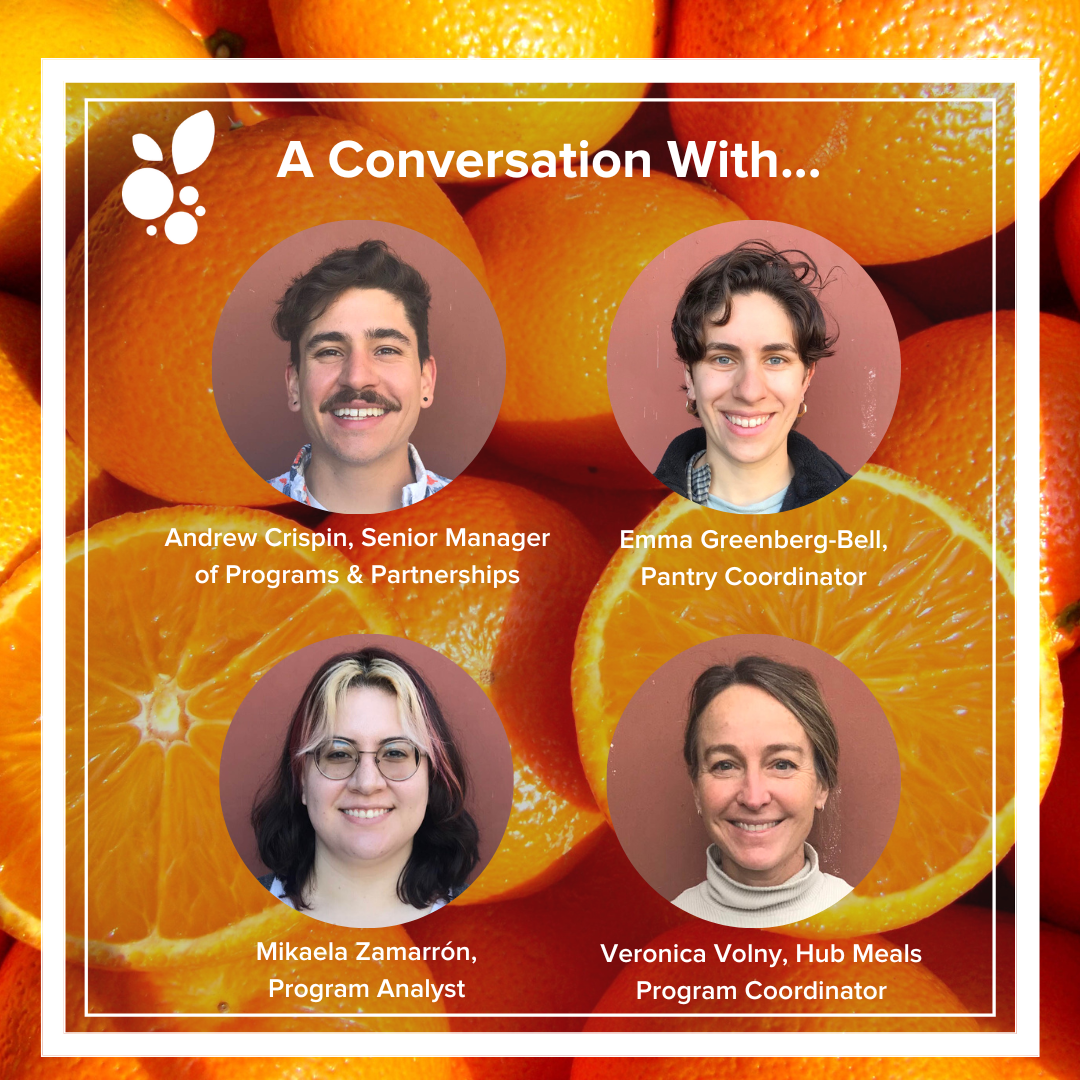
Andrew Crispin joined BFN in the spring of 2022 as Distributions Program Manager and was promoted late last year to Senior Manager of Programs and Partnerships. Since he joined BFN, he’s made major improvements to our onsite pantry operations and has strengthened our partnerships with mobile pantry and RDO partners. Andrew’s leadership and the addition of Hub Meals Program Coordinator Veronica Volny, Program Analyst Mikael Zamarrón, and the promotion of Emma Greenberg-Bell to Pantry Coordinator will build BFN’s capacity to serve more families facing hunger in 2023. Keep reading to learn more about BFN’s program goals this year and how the new team will help us get there.
Andrew, how did your position change come about and how will your new scope help move programs forward this year?
Andrew: When I started in my previous role, the overall direction of our programs and how we were managing distribution was unclear–there were panties, shelf-stable bags, and homebound boxes. BFN had experienced rapid growth in the number of people we were serving at the beginning of 2022 and when I came on board, our programs needed redefinition and clearer direction. Throughout the fall I started to talk with Sara about ways to improve them, building that infrastructure from the ground up, starting with our internal database to keep track of everything and to organize ourselves for success. To me, success for BFN means reaching more people using our existing services. We realized my position needed to grow because there was so much more responsibility that comes along with it. A lot of it comes down to the partnership management piece: establishing strong relationships with organizations to figure out where we can have more mobile pantries and the customer service aspect with our existing partners to see how we can better serve them, so they are getting the food they need to serve their communities. At this point, it feels great to see some of these changes programmatically and partnership-wise come to fruition.
What is your vision for the onsite pantry in 2023 and how will Emma Greenberg Bell’s new position as Pantry Coordinator will support that?
Andrew: Our onsite pantry serves about 25% of the individuals we support. Being almost exclusively volunteer-run, the onsite pantry historically didn’t have much staff structure to make it a fully fleshed-out program. Having Emma promoted to Pantry Coordinator, we now have staff time and resources put into managing and growing this program to create something reflective of our personality and identity in the community. Some key changes we’re hoping to make this coming year will be around framing our onsite pantry as a more welcoming environment. We are considering creating a welcome tent where folks from the community can feel relaxed to engage with the organization, rather than standing in line in the parking lot.
Emma, what have you noticed at this onsite pantry and how do you think these changes will help us better serve our community?
Emma: The onsite pantry started as a client-choice pantry in November 2019. It grew many times over during COVID. From March until August 2020, we pivoted to providing our clients with custom-packed bags, but in August 2020, we moved the pantry outside and returned to a client-choice distribution. The program is operated directly out of our warehouse, so we have the advantage of providing the community with more resources than our mobile pantries. When we create our welcome tent, we will be able to provide even more resources to folks coming through, such as information about our mobile pantries and other food services that could be useful to them.
Emma and Andrew, what are you envisioning for the mobile pantry programs this year?
Emma: We have two types of mobile pantries: private for participants in specific programs and locations, and public which are open to anyone. The private pantries create a community gathering space for folks who participate in programs or live at locations who, for example, were getting prepacked bags of groceries from BFN delivered to their door or going elsewhere for our services, and now it’s centered at their residences. We’d like to grow the ways we are building a community around the food we are distributing and expand access in different places we aren’t currently serving.
Andrew: To add to that, there are three major ways we are looking to expand this program. One is the number of mobile pantries. We want to identify geographic areas where there are gaps in our services. Two, improve our data collection to know who we serve and how we can better support them. Third, embrace our community-centric model and create a feedback loop, where folks in the community can say to us “yes, I like this kind of kale” or “no I don’t want this type of tomato sauce” so we can bring this information to our sourcing team and identify better items to distribute.
Mikaela Zamarrón has joined us recently as a Program Analyst. How is Mikaela’s work going to help BFN understand who we are supporting?
Andrew: Mikaela will be instrumental in helping with a lot of that foundational work of first identifying a new mobile pantry location. Secondly, she will help us refine and develop how we do data collection as an organizational practice onsite and in our mobile pantries.
Mikaela, what brought you to BFN?
Mikaela: I am a graduate student at the School of Public Health at UC Berkeley. Before this, I worked for a food bank in Detroit on a program called Cooking Matters which is direct nutrition education, but within that, similar to pretty much every food bank, there was a lot of pivoting during the COVID. As a result, I’ve taken on a lot of roles within the foodbank sphere: surveying, content creation, and leading distributions. Before that, I worked as a cook at a restaurant and graduated from the University of Michigan with degrees in international studies and Spanish.
Another new face on board is Veronica Volny, heading up our Hub Meals program as the Hub Meals Program Coordinator. Veronica, how’re things going there and what’s your vision for this program?
Veronica: It’s going great. We have three 4-hour sessions each week to cook, and it’s just the volunteers and me. After a month there, I think I’ve figured out what is a reasonable amount of food to prep, triage, wash and prepare to produce enough meals for our distributions.
It’s a huge pleasure to witness the volunteers’ dedication to the program. It’s also amazing to see how much recovered food we can go through in 12 hours a week. I am always thinking about the final number of meals we are getting out there. I want it to be more, of course. But I also feel quite attached to the ingredients we work with. We could be opening giant cans of food, combining them, and plating them, and that would get a certain amount of calories out there. But I don’t think that is necessarily the best. It’s nice to know that the community members getting these meals can enjoy different types of ingredients.
I am excited that BFN is working with all this amazing fresh produce that’s coming in and we can take some of that and turn it into these beautiful meals. That takes a lot of work and labor, even just triaging it. While it’s beautiful, much of it is recovered and it requires more careful sorting than if you just bought a pristine bunch of something. It’s a balance between trying to go for volume and staying committed to the types of recovered ingredients that we can work with. It’s important not just because of nutritional value and taste, but tracing back to businesses where we are sourcing the food and ultimately the farmers who grow it. So much of it is organic from regional farms we are familiar with, and it’s thrilling to be able to engage that whole chain from the people who are growing the food to the people who are eating it. BFN is one link in that chain, salvaging that food that no longer has economic value and getting it to people who need it.
Are the Hub Meals distributed at the pantries and in food boxes to home-bound community members?
Andrew: Yes, primarily the homebound boxes, and the rest go to the pantries. A goal for the homebound program is to dial in on what we are setting aside for those recipients. Based on the conversations I’ve had with these folks, they are the most vulnerable, so access to food for them is very complicated. We want to make sure we have those meals for them.
The homebound program has long been a pilot, and a goal for this year is to make it a true program that we can control and maintain. That will include recruiting volunteer drivers, setting standards on what types of food goes in these grocery boxes, and setting eligibility criteria.
How about our self-stable bags that are distributed to organizations supporting unhoused folks and to schools?
Andrew: We make the same 600 shelf-stable bags each week for distribution through schools and to organizations serving unhoused community members. But we are looking at fine-tuning this program to support the recipients better. For example, a piece of feedback we received recently from the schools we partner with is that some of the families want more easy-to-cook foods. We are looking at ways to identify what those foods are and finding the balance between nutrition, sustainability, and agency in what we provide. We heard that folks want to see macaroni and cheese. Normally that’s not something we source. It’s about incorporating this feedback and honoring the community as a key stakeholder in this work.
BFN is a Redistribution Organization (RDO) that provides food in bulk to community organizations in Northern Alameda running their own food assistance programs. How do you see our partnerships with our RDO organizations growing this year?
Andrew: During COVID, it was like Oprah: “You get food! You get food! You get food!” but there was no work on tracking these partners or asking what food they need and want. At this point, we have a list of partners on standby that want to receive food but have yet to be onboarded. This year we want to implement a quarterly feedback process where each of these partners can communicate the foods they want to receive, informing our sourcing and improving our customer service. The customer service and community integration pieces are integral for BFN to succeed relative to other organizations in this space. We want to improve the types of food we are providing to RDO partners.
This year, I see the number of RDO partners we are serving greatly increasing. I also see us getting a better glimpse into the communities they serve through this feedback process. We don’t know who our RDO partners are serving and how with the food we provide. Understanding where our food goes and how it gets to the end consumer will be key for us.
